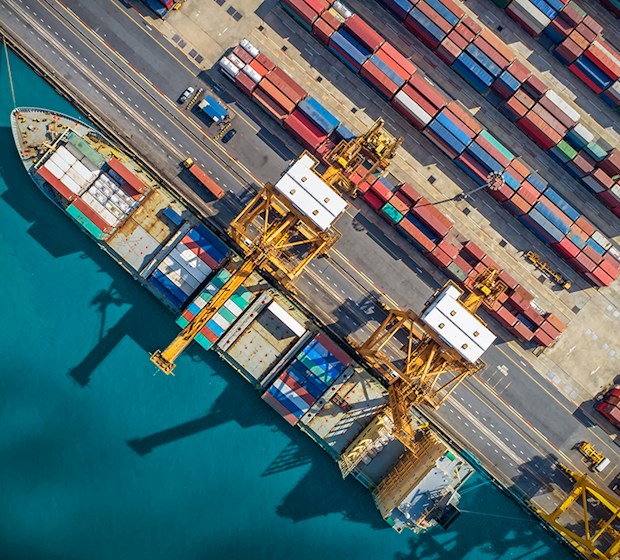
Understanding Coats
Market trends
“Coats continues to challenge itself, changing course to keep meeting the needs of our customers by supplying high-quality, agile solutions in a transient market.”
Rajiv Sharma
Group CEO
“As the leader of Apparel, I am excited at what opportunities the domestic Asia market holds for us, particularly within China and India.”
Adrian Elliott
Chief Executive Officer - Apparel
1. Volatile Economic Climate
The industries we serve, like most consumer focused industries, react to macro economic factors such as rising cost of living and higher than normal inflation in raw materials, freight, energy and labour. 2022 saw headline consumer inflation exceed c.10% globally, which impacted demand across our Apparel business, and to a lesser extent our Footwear business, during the latter half of the year, in addition to the increase in input costs. Although we saw a softening of some inflationary pressures towards the end of 2022, we are still cognitive of a high inflationary and volatile economic environment as we move through 2023.

Trend #1: Our response this year
Coats moved early to address the inflationary risk, managing to fully offset inflation during the year. We have offset inflation in the areas of raw materials, freight, energy and labour with pricing and self-help programmes.
By continuing to deliver on Speed, Productivity, Innovation, Quality, Reliability and Sustainability (SPIQRS) and focusing on the premium end of the market, Coats is strategically positioned to successfully navigate economic headwinds.
2. Supply Chain Disruption
Across the industries we serve, speed to market is increasingly a critical differentiator. Our customers are looking at their own supply chain resilience, including reviews of their supply base and sourcing geographies. During 2022, we saw industry supply chain disruption with reduced availability of raw materials, labour constraints and disruption of sea freight operations, all contributing to higher than normal levels of inflation globally. We expect these challenges to largely continue into 2023, increasing the importance of speed, agility and supply resilience across the industries we serve.
Trend #2: Our response this year
We have a resilient and global operational footprint, which offers peace of mind and superior reliability to our customers. We pivot quickly, responding to and supporting our customers’ needs in a highly volatile environment. Our unrivalled global, agile footprint, and our scale proved invaluable as we delivered high levels of supply and customer service, despite multiple external challenges.

3. Sustainability
Sustainability continues to increase in importance across the industries we serve, driven by consumer pressures, customer strategies and legislative changes. COP27 delivered further global progress across the environmental agenda. This continued shift in sentiment and behaviours is manifested in areas such as materials innovation, energy renewables, water management, waste reduction and social justice and compliance. Many of our customers are developing partner programmes that put sustainability at the heart of ongoing collaboration. Our expectation is that this trend is irreversible and will only increase in importance over time.

Trend #3: Our response this year
We have continued to advance our sustainability journey in 2022 with positive progress made on our ambitious targets to deliver reductions in energy and water intensity. Collaborating with our supply chain partners we have delivered higher levels of circularity as a means of driving waste prevention and reduction.
Our recent Texon and Rhenoflex acquisitions both have sustainability strategies aligned to those of Coats, with footwear component solutions such as Rhenoprint delivering waste free production.
4. Growth of Asian Domestic Markets and Asia Brands
Domestic consumer demand in Asia is significant and expected to grow faster than JUSE (Japan, USA, Europe) markets. Globally, as a derived demand component, sewing thread markets are expected to grow by low single digits percentage over the medium term, but with higher growth in Asia as demographics and consumer wealth expands. This is reflected in the growth of domestic fashion retail, most notably, but not only, in China and India. Demand for Composites is increasing due to the pace of urbanisation (e.g. the rollout of fibre optic cable networks) and economic growth, which means consumers buy more products needing high performance materials (e.g. outdoor goods and passenger vehicles). In personal protection, demand is being driven by increasing levels of worker protection, industry regulation and the need for comfort with multi-hazard protection.
Trend #4: Our response this year
We continued to develop and execute our domestic market growth strategies in China and India, building on our competitive advantages of product range, quality, technical application and brand strengths. In Apparel and in Footwear, we delivered market share gains and significant growth in China and made strong progress coming out of continued Covid disruption. In Performance Materials, we delivered significant share gains in China in Performance Threads with multiple new programme wins for automotive safety critical and trim applications. We also had a very successful start producing and selling FlamePro branded flame-retardant fabrics in India mainly for use in garments destined for the middle eastern oil and gas market. Our two acquisitions in the footwear space are well positioned in China and Vietnam, and poised to take advantage of further Asia-driven growth.

5. Digital
Industry adoption of digital technology has continued to accelerate during 2022 as companies look to drive faster speeds, increased productivity, lower waste and end-to-end supply and materials transparency. We continue to embed our investments in technology of recent years to improve our supply chain and support functions, and remain as vigilant as ever of cyber security threats.
Digital technology across the industry is not limited to pure software solutions, as the industry becomes more and more responsive to sustainability-led innovations, we are seeing increased demand for solutions that use technology to simultaneously reduce waste and increase productivity.

Trend #5: Our response this year
Coats Digital, our Fashion Tech business, enables fashion brands, sourcing companies, and manufacturers to optimise, connect and accelerate business critical processes seamlessly, including: design and development; method-time-cost optimisation; production planning and control; fabric optimisation and shop floor execution. In 2022 bookings saw high double-digit growth ahead of reported sales growth, indicating confidence for continued future growth.
In our Footwear division we acquired, as part of the Rhenoflex acquisition, the proprietary ‘Rhenoprint’ 3D printing IP, which offers leading brands a zero waste, print-to-order solution with enhanced performance within the shoe.
In Apparel, we have begun selling Twine, our waterless digital colour printing technology solution that is integrated into Coats’ own colour catalogue. This allows colour development in garments to be done in minutes, not weeks.
Rhenoprint and Twine in particular exemplifies how Coats is connecting talent, textiles and technology to make a better and more sustainable world.
